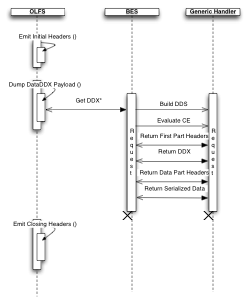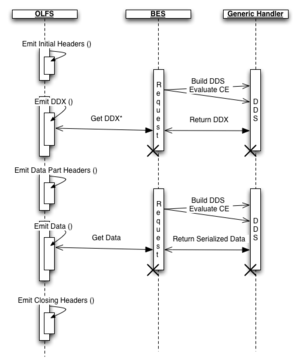How to build the DataDDX response in/with Hyrax
Division of Labor

The BES and OLFS work together to support DAP, however, it is the job of the OLFS to correctly implement the DAP. The BES understands certain aspects of the DAP, but it does not actually build correct responses from DAP requests. Instead the OLFS reads a request and asks the BES to build parts of the correct response that it then assembles to make the complete response document.
To build a DataDDX response, the OLFS and BES will work together as shown in Figure 1. When the OLFS receives and processes a DAP4 DataDDX request, it will first parse from that request the information the BES needs and send that along with both the Multipart MIME (MPM) start and boundary values. The BES will use a handler to build a C++ DDS object and return the MPM document that forms the payload of the DataDDX response, with a few wrinkles, such as why the start and boundary values need to be passed by the OLFS to the BES, to be described shortly.
When the OLFS begins to receive the MPM payload for the DataDDX response, it will first write out the MIME headers for the response. Following that, it will stream the response from the BES, and following that, it will append (send to the stream) the closing section of the document.
Note: In Figures 1 and 2 the OLFS, the sequence of interactions between theBES and a generic Handler are shown using a UML sequence diagram. That type of diagram is intended to be used for objects and their methods, but I thought it was a useful diagram even though the idea of the BES, OLFS or a handler as an object is a bit of a stretch.
Handler
The Handler running inside the BES uses libdap's DDS class and its methods to make the DDX and XDR-encoded data blob. A new function will be added to libdap's collection of MIME-header writers to build the MPM boundary sections.
